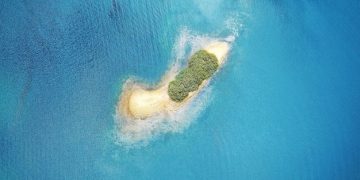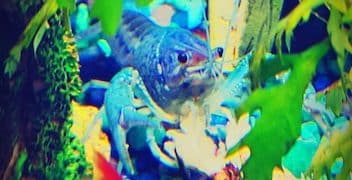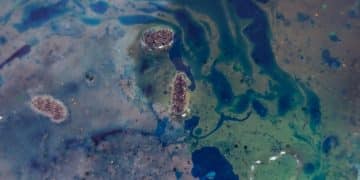US Marine Life & Microplastic Ingestion: What Can Be Done?
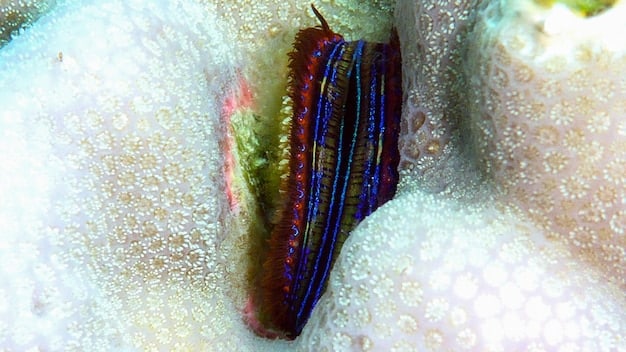
Recent estimates highlight the concerning rates of microplastic ingestion by marine life across US waters, revealing significant ecological consequences that necessitate urgent, multi-faceted intervention strategies focused on reduction, research, and policy enforcement to safeguard marine ecosystems.
The ubiquity of plastic has led to an environmental crisis, with microplastics emerging as a silent but pervasive threat to marine ecosystems. Understanding What are the Latest Estimates of Microplastic Ingestion by Marine Life in US Waters, and What Can Be Done? is crucial for addressing this complex issue. This article delves into the current scientific understanding of microplastic ingestion by marine life in US waters, exploring the pathways through which these microscopic particles enter the food web and the far-reaching implications for aquatic biodiversity and human health.
The Silent Invasion: Understanding Microplastic Pathways in US Waters
Microplastics, defined as plastic particles less than 5mm in size, infiltrate marine environments through various routes, primarily from larger plastic debris that fragments over time due to UV radiation and physical abrasion. In US waters, their presence is not localized but widespread, impacting coastal areas, estuaries, and even the deep sea. These tiny fragments originate from consumer products, industrial processes, and the degradation of larger plastic items, making them an omnipresent pollutant.
The journey of microplastics from land to sea is multifaceted. Wastewater treatment plants, while effective at removing some pollutants, often fail to capture microfibers from clothing or microbeads from personal care products, which are then discharged into rivers and eventually ocean currents. Stormwater runoff carries tire dust, paint flakes, and other plastic debris from urban and agricultural lands directly into aquatic systems. This continuous influx means that even pristine-looking US waters are not truly free from microplastic contamination.
Sources and Distribution
The primary sources of microplastics are diverse, ranging from synthetic textiles and tires to industrial pellets and paint. Once in the marine environment, they are distributed by prevailing ocean currents, wind, and even marine organisms themselves. Their small size allows them to be suspended in the water column, settle in sediments, or be carried far afield, making their removal virtually impossible once dispersed.
- 👕 Microfibers from synthetic clothing (polyester, nylon) released during washing cycles.
- टायर dust particles from vehicle wear and tear on roads.
- 🧴 Microbeads from personal care products, though largely phased out, persist in older waste streams.
- 🎨 Fragments from paint, fishing gear, and other plastic products that break down over time.
Understanding these pathways is the first step in formulating effective mitigation strategies. Without curbing the flow of microplastics at their source, efforts to protect marine life will always be reactive rather than proactive. The interconnectedness of waterways in the US means that pollution from one region can quickly affect ecosystems hundreds of miles away, highlighting the need for a national, cohesive approach to plastic waste management.
The interaction of microplastics with organic matter in the water column also influences their distribution. Some particles can become colonized by microorganisms, altering their buoyancy and making them more likely to sink to the seafloor, accumulating in benthic habitats where many bottom-dwelling organisms reside.
Latest Estimates: Quantifying Microplastic Ingestion by US Marine Life
Recent scientific studies have dramatically improved our understanding of microplastic ingestion rates across various marine species in US waters. While precise, species-specific figures are still evolving, the overall trend is concerning: virtually all trophic levels, from microscopic zooplankton to apex predators like whales and seabirds, are accumulating plastics. These estimates are derived from a combination of field observations, controlled laboratory experiments, and sophisticated modeling, often focusing on coastal areas, estuaries, and key migratory routes that concentrate marine life.
For example, research in areas like the Great Lakes and the Gulf of Mexico, which are integral to US aquatic ecosystems, reveals high concentrations of microplastics in water samples, sediments, and the digestive tracts of fish and shellfish. Studies have reported that a significant percentage of commercially important fish species caught in US waters, such as cod, haddock, and various types of sole, contain microplastic particles. This suggests a widespread problem rather than isolated incidents.
Species-Specific Findings and Trends
Different species show varying levels of ingestion depending on their feeding behavior, habitat, and geographical location. Filter feeders, like mussels and oysters, often exhibit the highest concentrations because they continuously process large volumes of water, inadvertently filtering out microplastics alongside their food. Small fish and invertebrates mistake microplastics for food, leading to their entry into the food web at lower trophic levels.
- 🐟 **Fish:** Studies indicate up to 70% of sampled fish in US coastal waters have microplastics in their guts.
- 🐚 **Shellfish:** Mussels and oysters can contain hundreds of microplastic particles per individual.
- 🐦 **Seabirds:** Over 90% of seabird species are estimated to have ingested plastic globally, with significant numbers in US populations.
- 🐋 **Marine Mammals:** Whales, seals, and dolphins, especially filter-feeding baleen whales, are also found with plastics in their systems.

The long-term health consequences of this ingestion are still being investigated, but preliminary findings suggest potential physiological harm, including reduced feeding, impaired reproduction, and altered immune responses. The direct economic impact on fisheries and tourism is also a growing concern, as public perception of seafood quality could be eroded.
These estimates underscore the pervasive nature of microplastic pollution and its insidious impact on marine life within US waters. The challenge lies in refining these estimates and understanding the full ecological implications, which requires sustained and collaborative research efforts across federal agencies, academic institutions, and environmental organizations.
Ecological and Physiological Impacts on Marine Organisms
The ingestion of microplastics by marine life extends beyond mere presence in the gut; it carries a range of ecological and physiological consequences that can disrupt individual organisms, populations, and even entire ecosystems. Ecologically, microplastics can interfere with feeding behavior, reduce energy uptake, and potentially alter species interactions. Physiologically, they can cause physical damage, introduce toxic chemicals, and affect metabolic processes, ultimately impacting survival and reproduction.
When marine organisms ingest microplastics, two primary concerns arise: the physical effects of the particles themselves and the chemical effects of contaminants adsorbed onto the plastic or those released from the plastic material. Physically, microplastics can cause internal abrasions, block digestive tracts, and create a false sense of satiation, leading to reduced food intake and malnutrition. This is particularly problematic for smaller organisms where even a few particles can occupy a significant portion of their digestive system.
Physical and Chemical Consequences
The physical presence of microplastics can lead to direct harm. For example, sharp edges of plastic fragments can damage the gut lining, causing inflammation or internal bleeding. In filter feeders, large quantities of microplastics can clog feeding apparatus, reducing filtration efficiency and nutrient absorption. This reduction in energy intake can lead to slower growth rates, decreased physical fitness, and lower reproductive output, influencing population dynamics.
- 🚫 Blockage and physical damage to digestive tracts.
- 🍚 Reduced food intake due to false satiation.
- 🧪 Leaching of toxic chemicals (e.g., phthalates, BPA) from plastic.
- 🦠 Adsorption of environmental contaminants (PCBs, heavy metals) on plastic surfaces.
Chemically, microplastics act as vectors for harmful substances. Plastics themselves are often manufactured with additives like phthalates and flame retardants, which can leach into the organism’s tissues upon ingestion. Moreover, microplastics are highly adsorbent, attracting and concentrating persistent organic pollutants (POPs) and heavy metals from the surrounding seawater. Once ingested, these adsorbed toxins can desorb and transfer to the organism, potentially bioaccumulating up the food chain.
The long-term effects of chronic exposure to these chemical cocktails are still being investigated but are thought to include hormonal disruption, immune system suppression, and reproductive impairment. These sub-lethal effects can weaken populations, making them more vulnerable to other environmental stressors like climate change and habitat loss. The comprehensive understanding of these impacts is vital for assessing the true ecological cost of microplastic pollution in US waters.
Human Health Implications from Marine Microplastic Ingestion
While the direct impacts of microplastic ingestion on marine life are increasingly documented, the implications for human health are a growing area of concern and active research. Humans consume marine seafood, including fish and shellfish, which are known to contain microplastics. This creates a potential pathway for microplastic transfer from marine ecosystems directly into the human diet. The question then becomes: what are the consequences of this dietary exposure?
Current scientific consensus acknowledges that humans are likely ingesting microplastics through various routes, including seafood consumption, drinking water (bottled and tap), and even airborne particles. Focusing on seafood, since microplastics are found in the gut and tissues of many marine species, there’s a risk of exposure, especially from shellfish like mussels and oysters, where the entire organism, including the digestive tract, is consumed. Fish fillets, while less likely to contain gut contents, may still harbor microplastics if particles have translocated into muscle tissue—though evidence for this is still emerging and debated.
Pathways to Human Exposure
The primary routes for human exposure to marine-derived microplastics are through the consumption of contaminated seafood. For species where the digestive tract is consumed, such as bivalves, the risk of ingesting microplastics directly observed in the animal’s gut content is higher. For fish, the concern shifts to the potential translocation of chemicals absorbed by or contained within the microplastic particles. This raises questions about food safety and the potential bioaccumulation of harmful substances.
- 🍝 **Seafood Consumption:** Ingestion of filter-feeding shellfish or fish that have consumed plastics.
- 💧 **Drinking Water:** Presence of microplastics in both tap and bottled water, originating from various sources.
- 🌬️ **Airborne Particles:** Inhalation of microplastic dust from synthetic textiles and other sources.
The health effects of ingested microplastics on humans are complex and not yet fully understood. Potential concerns include physical damage from the particles, the leaching of toxic chemicals (additives from the plastics or absorbed environmental pollutants), and the possibility of microplastics acting as carriers for pathogenic microorganisms. Research is ongoing to determine if these particles can cross biological barriers within the human body, such as the gut lining or the blood-brain barrier, and what long-term health consequences might arise from chronic exposure.
While direct, conclusive evidence linking microplastic ingestion to specific human diseases is still limited, the precautionary principle suggests that minimizing exposure is prudent. Public health agencies and food safety authorities are increasingly monitoring the presence of microplastics in food supply chains. This underscores the need for continued research into the toxicology of microplastics and for comprehensive strategies to reduce plastic pollution at its source, protecting both marine life and human health.
Innovations in Microplastic Detection and Mitigation
Addressing the pervasive issue of microplastic ingestion requires a multi-pronged approach, starting with improved detection methods and extending to innovative mitigation strategies. The ability to accurately quantify and characterize microplastics in water, sediment, and biological samples is fundamental to understanding their distribution and impact. Simultaneously, developing and implementing strategies to reduce the flow of plastics into the environment is paramount.
Advancements in analytical chemistry and spectroscopy are making microplastic detection more efficient and precise. Techniques such as Fourier-transform infrared (FTIR) spectroscopy, Raman spectroscopy, and pyrolysis-gas chromatography/mass spectrometry (Py-GC/MS) allow researchers to identify the polymer type, size, and shape of microplastic particles. These tools are crucial for tracing sources and understanding the specific types of plastics that pose the greatest threat to marine life in US waters.
Technological Solutions and Reduction Strategies
Beyond detection, a range of innovative solutions is emerging to tackle microplastic pollution. These strategies can be broadly categorized into source reduction, capture technologies, and bioremediation efforts. Source reduction focuses on preventing plastics from entering the environment in the first place, while capture technologies aim to remove existing microplastics from water bodies or wastewater streams. Bioremediation, though in its early stages, explores the use of biological agents to degrade plastics.
- 📈 **Advanced Filtration Systems:** Improved filters for wastewater treatment plants to capture microfibers.
- ♻️ **Circular Economy Initiatives:** Designing products for durability and recyclability to reduce new plastic production.
- 🌊 **Ocean Cleanup Technologies:** Development of large-scale systems to collect plastic debris from marine environments.
- 🔬 **Bioremediation Research:** Investigating microorganisms capable of degrading plastic polymers.
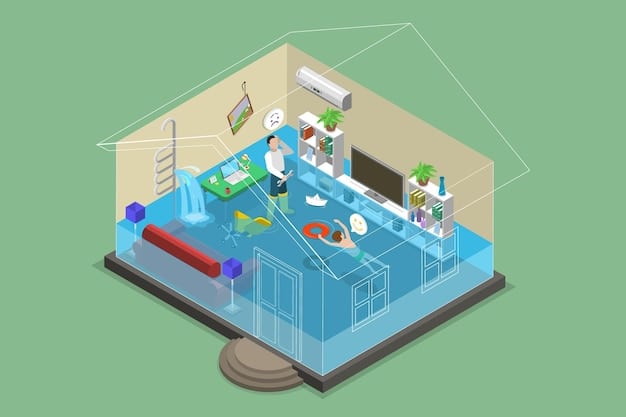
While large-scale ocean cleanups garner attention, the most effective long-term solutions lie in preventing pollution at its source. This includes promoting responsible consumer behavior, investing in robust waste management infrastructure, supporting policies that reduce single-use plastics, and fostering innovation in biodegradable alternatives. Collaborative efforts involving governments, industries, and the public are essential for scaling these innovations and achieving a significant reduction in microplastic pollution.
A promising area of research involves smart materials and self-healing plastics that could extend the lifespan of plastic products, delaying their breakdown into microplastics. Furthermore, green chemistry principles are being applied to design polymers that are inherently less prone to fragmentation or are more easily biodegradable under natural conditions. These innovations, combined with policy changes, offer hope for reversing the tide of microplastic ingestion by marine life.
Policy Frameworks and Community Action
While scientific understanding and technological innovations are crucial, sustained progress in combating microplastic ingestion by marine life in US waters ultimately depends on robust policy frameworks and widespread community action. Regulatory measures can mandate source reductions and improvements in waste management, while public engagement fosters behavioral change and supports the implementation of new initiatives.
At the federal level, policies such as the Microbead-Free Waters Act of 2015 have already targeted specific types of microplastics in personal care products. However, a more comprehensive approach is needed to address the broader spectrum of microplastic sources. This could involve national standards for wastewater treatment to better filter microfibers, incentives for industries to adopt circular economy principles, and research funding for biodegradable alternatives. State and local governments also play a vital role through bans on single-use plastics and investment in recycling infrastructure.
Legislative Efforts and Public Engagement
Legislative efforts are gaining momentum, driven by increasing public awareness and scientific evidence of microplastic harm. Proposals range from extended producer responsibility (EPR) schemes, which hold manufacturers accountable for the entire lifecycle of their plastic products, to deposit-return schemes for plastic bottles that incentivize collection and recycling. These policies aim to create a systemic shift away from a linear “take-make-dispose” model towards a more sustainable, circular economy.
- 🏛️ **Federal & State Legislation:** Implementing bans on single-use plastics and promoting recycling.
- 🤝 **International Cooperation:** Collaborating on global treaties to address transboundary pollution.
- 🚶 **Citizen Science Initiatives:** Empowering communities to monitor and report plastic pollution.
- 🌱 **Educational Programs:** Raising public awareness about plastic footprints and responsible consumption.
Community action is equally vital, encompassing initiatives from local beach cleanups and zero-waste campaigns to educational programs that inform the public about responsible plastic use. Citizen science projects, where volunteers help collect data on microplastic presence, contribute valuable information to scientific research and foster a sense of stewardship. Consumer choices, such as opting for reusable products, supporting brands with sustainable practices, and washing synthetic clothes less frequently or with microfiber-catching bags, collectively contribute to reducing plastic pollution.
The combination of top-down policy mandates and bottom-up community participation creates a powerful synergy for change. By fostering greater accountability from producers and promoting responsible behavior among consumers, the US can significantly reduce the influx of microplastics into its marine environments, thereby protecting marine life and safeguarding ecosystem health for future generations. The challenge is immense, but the collective will to act offers a promising path forward.
| Key Point | Brief Description |
|---|---|
| 📊 Microplastic Prevalence | Widespread issue across US waters, impacting all trophic levels from plankton to whales. |
| 🐠 Impact on Marine Life | Causes physical harm, chemical contamination, and ecological disruption. |
| 👨👩👧👦 Human Health Concerns | Potential exposure through seafood and drinking water, requiring further research. |
| 💡 Solutions & Strategies | Requires technological innovation, policy frameworks, and community involvement for reduction. |
Frequently Asked Questions About Microplastic Ingestion
▼
Microplastics are tiny plastic particles less than 5mm in size. They primarily enter US waters through the breakdown of larger plastic debris, laundry wastewater containing synthetic microfibers, tire wear, and industrial discharge. Stormwater runoff also carries these particles from land-based sources into rivers and oceans, leading to widespread contamination.
▼
While nearly all marine species are affected, filter feeders like mussels, oysters, and baleen whales show high ingestion rates due to their feeding mechanisms. Small fish and invertebrates also frequently ingest microplastics, making them a pathway for entry into the broader marine food web. Seabirds and marine mammals are also significantly impacted.
▼
Ingestion can cause physical damage, such as internal abrasions or digestive blockages, and lead to a false sense of satiation, resulting in malnutrition. Microplastics also carry and leach toxic chemicals, which can cause internal organ damage, reproductive issues, and compromise immune systems in marine organisms, affecting their overall health and survival.
▼
Yes, humans can ingest microplastics through the consumption of contaminated seafood, especially shellfish where the entire organism is eaten. While direct human health impacts are still under extensive research, concerns include the physical effects of particles and the transfer of absorbed chemicals from plastics. Minimizing exposure is a proactive measure.
▼
Solutions include improving wastewater treatment filtration, implementing stricter regulations on plastic production and waste management, and promoting circular economy principles. Individual actions like reducing single-use plastics, supporting sustainable brands, and participating in cleanups also contribute significantly to mitigating microplastic pollution.
Conclusion
The ubiquity of plastic, and particularly microplastics, in US waters represents a profound environmental challenge with far-reaching consequences for marine life, ecosystems, and potentially human health. The latest estimates confirm widespread microplastic ingestion across diverse marine species, underscoring the urgency of comprehensive action. Addressing this crisis necessitates a multi-faceted approach, combining cutting-edge scientific research, innovative technological solutions for detection and removal, robust policy frameworks at all governmental levels, and a collective commitment to responsible consumption and waste management. While the scale of the problem is daunting, the increasing awareness and collaborative efforts from scientists, policymakers, industries, and communities offer a promising path forward. Protecting marine life from microplastic ingestion is not merely an environmental imperative but a crucial investment in the health of our planet and future generations.

